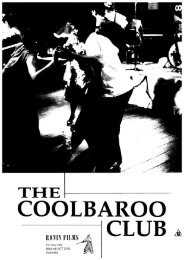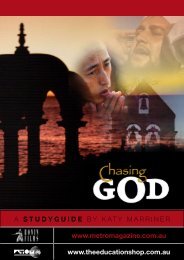What I Wrote: Katherine Thomson - Ronin Films
What I Wrote: Katherine Thomson - Ronin Films
What I Wrote: Katherine Thomson - Ronin Films
Create successful ePaper yourself
Turn your PDF publications into a flip-book with our unique Google optimized e-Paper software.
IntroductionThis study guide to accompany <strong>What</strong>I <strong>Wrote</strong>: <strong>Katherine</strong> <strong>Thomson</strong> has beenwritten for senior secondary students.It provides information and suggestionsfor learning activities in English,Literature, Theatre Studies and Drama.<strong>What</strong> I <strong>Wrote</strong>: <strong>Katherine</strong> <strong>Thomson</strong> is ashort film about Australian playwright<strong>Katherine</strong> <strong>Thomson</strong>. Dr Tess Brady interviews<strong>Thomson</strong> and provides a criticalintroduction to Harbour, Answeredby Fire, Mavis Goes to Timor andWonderlands. <strong>What</strong> I <strong>Wrote</strong>: <strong>Katherine</strong><strong>Thomson</strong> also includes a discussion ofsome of <strong>Thomson</strong>’s other plays and aninvestigation of her approach to writingfor the stage.<strong>What</strong> I <strong>Wrote</strong>: <strong>Katherine</strong> <strong>Thomson</strong>is one title from a four-part seriesspotlighting Australian playwrights.The series offers students informationabout the ideas and processes of theplaywrights, as well as the opportunityto hear what the playwrights have tosay about their work. Other titles availablein the <strong>What</strong> I <strong>Wrote</strong> series include:• <strong>What</strong> I <strong>Wrote</strong>: Matt Cameron• <strong>What</strong> I <strong>Wrote</strong>: Louis Nowra• <strong>What</strong> I <strong>Wrote</strong>: Hannie RaysonFurther information about the seriescan be found at .<strong>Katherine</strong> <strong>Thomson</strong><strong>Katherine</strong> <strong>Thomson</strong> is an Australianplaywright and screenwriter. Shebegan her career as an actor with theAustralian Theatre for Young Peoplein 1969. After writing her first play AChange in the Weather, <strong>Thomson</strong> wascommissioned by Film Australia towrite the film adaptation. <strong>Thomson</strong>’stheatre works include Diving for Pearls,Harbour, Navigating, Barmaids, MavisGoes to Timor and Wonderlands.She has also written extensively fortelevision. Her television screenplaycredits include Grass Roots, Wildside,Blackjack, Halifax f.p., Fallen Angels,G.P. and Something in the Air. <strong>Thomson</strong>was the co-writer of the televisionseries Answered by Fire and wrotethe screenplay for the film UnfoldingFlorence – The Many Lives of FlorenceBroadhurst. She has been Vice-Presidentof the Australian Writers’ Guildand President of Sydney PEN.About the filmmakersDr Tess Brady – PresenterDr Tess Brady is a highly respectededitor, researcher and teacher of writingat university level. She was theco-founding editor of the internationalonline scholarly journal TEXT and haspublished children’s picture books,adult radio drama, crime fiction, shortstories and popular non-fiction. Hermost recent publication is CreativeWriting: Theory beyond practice, withNigel Krauth.Catherine Gough-Brady –DirectorCatherine Gough-Brady is a documentaryfilmmaker. She has made worksfor a variety of media. Gough-Bradyhas produced and directed educationalvideos and web sites. Her ‘docugame’Docks Dispute is currently used intertiary management and industrialrelations courses.Using <strong>What</strong> I <strong>Wrote</strong>:<strong>Katherine</strong> <strong>Thomson</strong> in theclassroomThe writer’s context‘<strong>Katherine</strong> isn’t interested in the highand mighty.’– Dr Tess Brady• As you view <strong>What</strong> I <strong>Wrote</strong>: <strong>Katherine</strong><strong>Thomson</strong>, compile a list of statementsthat describe <strong>Thomson</strong>’splace in society.• Use the internet, critical essays andcommentaries to compile a detailedsummary of the contexts that shape<strong>Thomson</strong>’s work as a playwright.Discuss your findings with others inthe class.• Drawing on one of <strong>Thomson</strong>’s plays,determine how <strong>Thomson</strong>’s experienceof and attitudes to the world inwhich she lives have influenced the
<strong>Thomson</strong> uses this backdrop to tell thestory of a wharfie family. Sandy hasn’tbeen home for six years. He returns tofind his family divided. His wife doesn’twant to know him and his childrenhave not only grown up but havegrown away from his political values.The world has changed and Sandyisn’t sure about where he stands.• <strong>Thomson</strong>’s characters are flawedbut that is what makes them human.Compile a profile for one of<strong>Thomson</strong>’s characters. Use momentsand statements from the play todescribe and explain the character’snature and behaviour.• As the funeral pyre catches fire, whatelse goes up in flames?• The Federal Government and Patrickwere united in their decision tosmash the Maritime Union ofAustralia. Use print and electronicmedia texts to investigate the disputeand how it polarized the nation.• ‘ Harbour is a vivid exploration offamily, belief and identity.’ Is this howyou see the play?Mavis Goes to TimorMavis Taylor was an 86-year-old grandmotherand retired haberdasher whenshe decided to take affirmative actionand help alleviate the suffering of theTimorese. <strong>Thomson</strong>’s play Mavis Goesto Timor portrays what happens whenMavis takes her sewing machines toTimor. She confronts the devastationcaused by the military occupation,disregards the bureaucratic red tapeand does not give in to self-doubt.<strong>Thomson</strong> created Mavis Goes to Timorwith Angela Chaplin and Kavisha Mazzella.• <strong>Thomson</strong>’s play was inspired by adocumentary called Mavis Goes toTimor. View the documentary. <strong>What</strong>moments of the documentary do youfind inspiring?• ‘Mavis’ story is an affirmation thatspirited, committed people, nomatter what their age, can make adifference.’ Discuss this assessmentof Mavis Goes to Timor by drawingon moments and statements fromthe play.Wonderlands‘Old friends are facing new animosities.’– Dr Tess Brady‘This is a play about history. About howhistory shapes us, how we become ourown history.’– Dr Tess BradyWonderlands is a play about belonging.<strong>Thomson</strong> portrays the complexityof ownership and inheritance. <strong>What</strong> I<strong>Wrote</strong>: <strong>Katherine</strong> <strong>Thomson</strong>acknowledges that <strong>Thomson</strong> wantedher audience to feel tugged between abattle of histories.The Yirralong people have lodged a nativetitle claim for their ancestral land.Lon, a third-generation pastoralist fearsthat his dream of passing the familyproperty Ambertrue on to his son-inlawwill be destroyed.• ‘This is history, Sandra, history. Bitof advice. Lugging history on yourback’s a sure-fire way to become apain in the neck.’Use this quotation to begin the class’discussion of Wonderlands.• Brady suggests that Alice is toomuch of a ‘goodie goodie’ for herliking. <strong>What</strong>’s your opinion of Alice?• ‘We have to find new ways to moveforward.’ Is this the message ofWonderlands?Diving for Pearls‘A play about change and how wecope with it.’– Dr Tess BradyAn industrial plant is closing down notbecause it is inefficient or the companyis running at a loss, but becausethe site has become prime real estatevalue. Den, the quiet plodder is nowfacing an uncertain future. He doesn’twant to change. Barbara does. The
problem is that her ambitions areunrealistic.• ‘And I don’t mind Housing Commission,I never have, but we’ve all livedin each other’s pockets for too long.I’ve won every prize at bingo, I’veborrowed every decent video, andI’m starting to go off the football …’Why is Barbara’s solution differentand doomed to fail?• ‘I didn’t want to write about victims.’– <strong>Katherine</strong> <strong>Thomson</strong>Examine the role the characters ofDiving for Pearls play in their owndownfall.• Do you think Diving for Pearls is anangry play?Navigating‘This is a play that reminds us that ourown histories are made up of the goodand bad we do.’– Dr Tess BradyBea wants to build a monument butthe town doesn’t want to rememberthe boating accident that claimed life.The past is painful and the residentssee no reason to revisit the tragedy. Tocomplicate matters, Bea finds herselfin possession of damagingdocumentary evidence exposing corruptionand buried secrets. Her worldbegins to crumble.Navigating is about the role andimportance of memory. <strong>Thomson</strong> asks,if we don’t remember what happenedin the past how can we strive for abetter world?• Define the term ‘whistleblower’.Can you think of any real worldexamples?• <strong>What</strong> does Navigating tell us aboutmemory?• ‘Silence is as damaging as speech.’Do you agree? Draw on momentsand statements from the play tosupport your evaluation.The writing process• ‘I quite like to have a plan, even if Idivert from it.’– <strong>Katherine</strong> <strong>Thomson</strong>Drawing on <strong>Thomson</strong>’s statementsin <strong>What</strong> I <strong>Wrote</strong>: <strong>Katherine</strong> <strong>Thomson</strong>,discuss how she creates andstructures the drama.• Naturalism is the re-creation of reallife or life as it is onstage. It seeks toreproduce realistic characters,situations or conflicts and usuallyoccurs in real time with sets, propsand costumes that are representativeof the situation, place or period.Drawing on one of <strong>Thomson</strong>’s plays,find evidence to contribute to adiscussion of <strong>Thomson</strong>’s decision tocreate naturalistic theatre.• ‘People don’t want to have theirshortcomings shoved in their face.’– <strong>Katherine</strong> <strong>Thomson</strong>Discuss the way <strong>Thomson</strong> usestheatre to highlight our failings as asociety and as individuals.• Were you surprised to learn that<strong>Thomson</strong> writes the first draft of aplay by hand? Debate the merits ofpen and paper versus wordprocessing.• Have you ever experienced writer’sblock? <strong>Thomson</strong> claims that overcomingwriter’s block is a matter ofremaining patient and letting the rightstory find you. Do you agree? Shareyour solutions to writer’s block withothers in the class.• When you start a play you want tostart at a position of balance butwhere everything’s about to change.’– <strong>Katherine</strong> <strong>Thomson</strong>Examine the opening scenes of<strong>Thomson</strong>’s plays to test the validityof this claim.• ‘We’re always writing aboutourselves.’‘The autobiographical elements areoften contained in what thecharacter wants and what thecharacter needs.’– <strong>Katherine</strong> <strong>Thomson</strong><strong>Thomson</strong> makes these claims of herown writing. Do such statements ringtrue for you?• ‘In theatre it’s the language thatcarries the drama.’– <strong>Katherine</strong> <strong>Thomson</strong><strong>Thomson</strong>’s plays are characterizedby the exchange of conversation.Dialogue is more important thangreat speeches. Part of <strong>Thomson</strong>’sresearch is to record conversationswith people whose stories areconnected to the stories she wantsto tell. The transcriptions of theseconversations help her shapecharacters’ dialogue.Select a <strong>Thomson</strong> character that youknow well. Develop an analysis ofwhat they say and how they speak.<strong>What</strong> do you notice? Now examinean exchange between this characterand another character from the play.<strong>What</strong> do you notice?• ‘They’re the person I start theconversation with.’– <strong>Katherine</strong> <strong>Thomson</strong><strong>What</strong> insights does <strong>Thomson</strong> provideabout the role of her dramaturges?• Were you interested to learn about<strong>Thomson</strong>’s commitment to research?• ‘The rehearsal’s to see where thecracks are.’– <strong>Katherine</strong> <strong>Thomson</strong><strong>What</strong> is <strong>Thomson</strong>’s view of therehearsal process?• Were you surprised by <strong>Thomson</strong>’s
attitude to the audiences who viewher plays?• <strong>Thomson</strong> offers her best writing tipsin <strong>What</strong> I <strong>Wrote</strong>: <strong>Katherine</strong> <strong>Thomson</strong>.<strong>What</strong> tip do you think you will follow?• ‘… we have our own stories andmustn’t take them for granted.’– <strong>Katherine</strong> <strong>Thomson</strong>‘We have to be really vigilant aboutAustralian stories being on stage andscreen.’– <strong>Katherine</strong> <strong>Thomson</strong><strong>Thomson</strong> is a member of the AustralianWriters’ Guild (AWG). In <strong>What</strong> I<strong>Wrote</strong>: <strong>Katherine</strong> <strong>Thomson</strong>, <strong>Thomson</strong>explains her decision to becomea member of AWG. Find out moreabout AWG and how it supportsAustralian writing and Australian writers.• PEN is an association of writersdevoted to freedom of expression inAustralia and in the world at large.PEN uses its influence on behalf ofwriters anywhere who are silencedby persecution, exile or imprisonmentand acts as an authoritativesource on all matters of freeexpression.Visit PEN at . As a class, discuss the worth ofthe organization.Analytic responsesThe following topics could be used forwritten text responses, debates, paneldiscussions and online forums.• ‘No playwright in this country doeshuman dramas about political issuesbetter than <strong>Thomson</strong>.’ Discuss.• ‘The courage of ordinary people is atthe heart of <strong>Thomson</strong>’s writing.’From script to stage• Create and present a short soloperformance from one of <strong>Thomson</strong>’splays. Submit a short written reportthat describes and analyses theprocesses used to create and presentthe performance.This program is available from <strong>Ronin</strong> <strong>Films</strong>.PO Box 1005 Civic Square ph: +61 2 6248 0851ACT 2608 Australia fax: +61 2 6249 1640sue.faulkner@roninfilms.com.auwww.roninfilms.com.auPrinted play scripts are available from Currency Press at .This study guide was produced by ATOM© Snodger Media editor@atom.org.auFor more information on Screen Education magazine, or to download other free study guides,visit .For hundreds of articles on Film as Text, Screen Literacy, Multiliteracy and Media Studies,visit .Notice: An educational institution may make copies of all or part of this study guide, provided that it only makes and uses copies asreasonably required for its own educational, non-commercial, classroom purposes and does not sell or lend such copies.



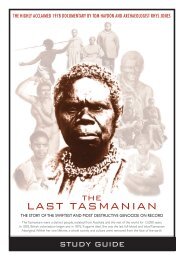

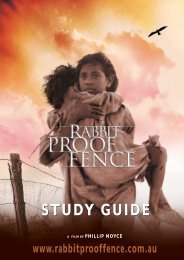

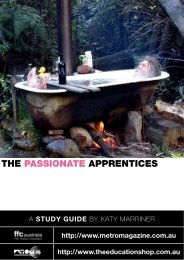
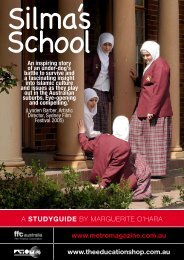
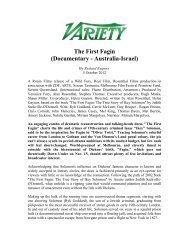

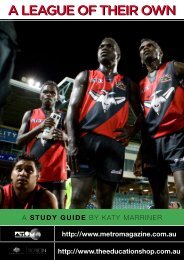
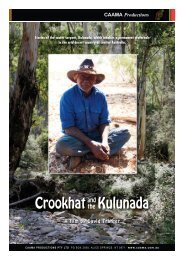
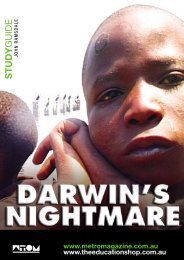
![to download FROHE OSTERN! [HAPPY EASTER!] - Ronin Films](https://img.yumpu.com/33740736/1/184x260/to-download-frohe-ostern-happy-easter-ronin-films.jpg?quality=85)
